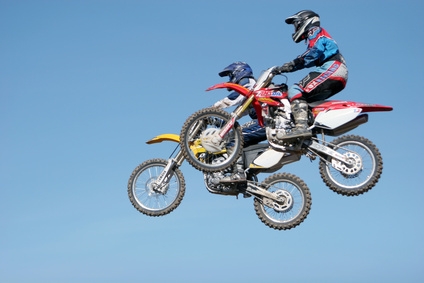
Dirt bikes, being mostly two-stroke designs, with some four-stroke engines occasionally used, take a pounding during a regular ride or extended outing. The piston and piston rings have the job of holding combustion pressure tight with no leaks. Extreme temperatures, lean carburetor jetting, rushed engine warm-ups and lack of clean lubricating oil can all contribute to piston and ring failure. Catching a compression problem early can fend off very expensive engine repair later. Narrowing down piston and ring defects requires a few steps and some special tools.
Place the dirt bike on its utility kickstand, if it has one. If not, the regular kickstand will do. Start the bike, and let it run for five to ten minutes at idle. Use the throttle to increase the rpm until you've reached a fast idle for a minute or so, then rev the engine a few times.
Listen for a muffled bell sound coming from the cylinder head every time the piston fires. Such a sound points to piston slap, which means the piston skirt has worn and slaps against the cylinder wall. A rod knock sounds more metallic and louder than piston slap.
Look at the condition of the exhaust while revving the engine. A normal two-stroke engine will exhibit some white or whitish gray emission. If the exhaust looks overly thick and the revving produces copious clouds of white smoke, along with a burnt-oil smell, it indicates excessive oil consumption that could be the result of worn piston rings. Pull the oil crankcase dipstick for a four-stroke engine. If the oil appears thinned out and smells of gas, it indicates fuel has passed between the piston rings and entered the crankcase.
Turn the gas tank petcock valve to the "off" position. Activate the ignition cut-off switch. Use a socket to loosen and remove the gas tank mounting bolts. Remove the fuel inlet hose from the gas tank. Pull the tank off the frame. Pull the plug wire off the spark plug tip, and direct it away from the plug hole. Use a socket to loosen and remove the spark plug. Insert a compression gauge screw-in adapter into the spark plug hole. Kick the manual starter over several times.
Read the compression psi (pounds per square inch) on the compression gauge. Refer to your owner's manual for the specified psi your bike requires. Generally, most high-compression dirt bike engines require from 125 to 150 psi, with some as high as 170 psi. A drop of more than 30 psi under your manual's specification indicates insufficient compression. However, a burnt valve will give such a reading, but also exhibit a noticeable engine miss. No miss and a low psi reading points to worn rings.
Unscrew the compression gauge from the spark plug hole. Insert a wooden dowel inside the spark plug hole.Turn the engine over by hand by pushing the kick starter lever until the dowel moves up to its highest position, which indicates top-dead-center. Remove the dowel. Insert a hand-pump pressure gauge hose into the spark plug cylinder. Screw it in with the provided adapter. Pump the pressure up to 80 to 90 psi.
Remember the highest reading, whichever psi pressure you decide on. Watch the gauge for several minutes. If the psi drops more than 30 percent psi in four to five minutes, you have a compression default. To narrow down worn piston rings, listen for air escaping from the breather vent or PCV location. Air escaping from the carburetor throat or tailpipe will not be worn pistons or rings.